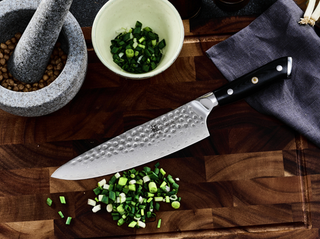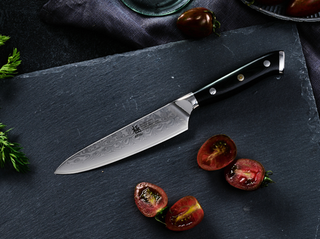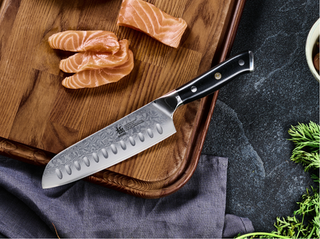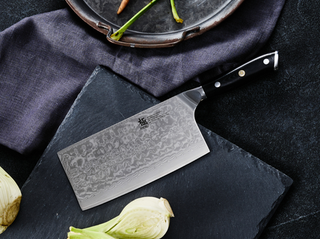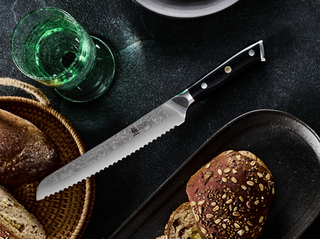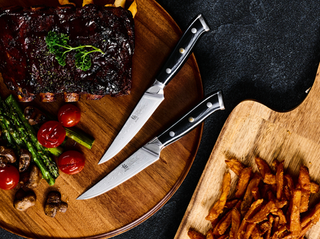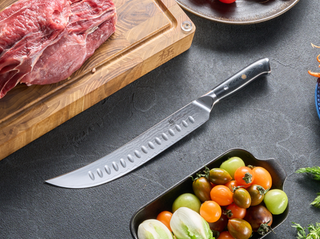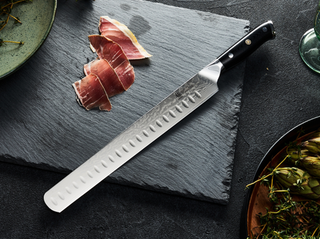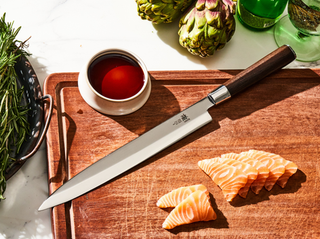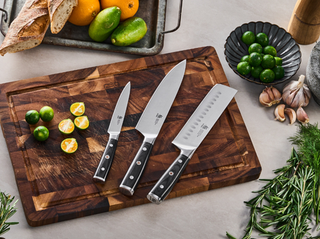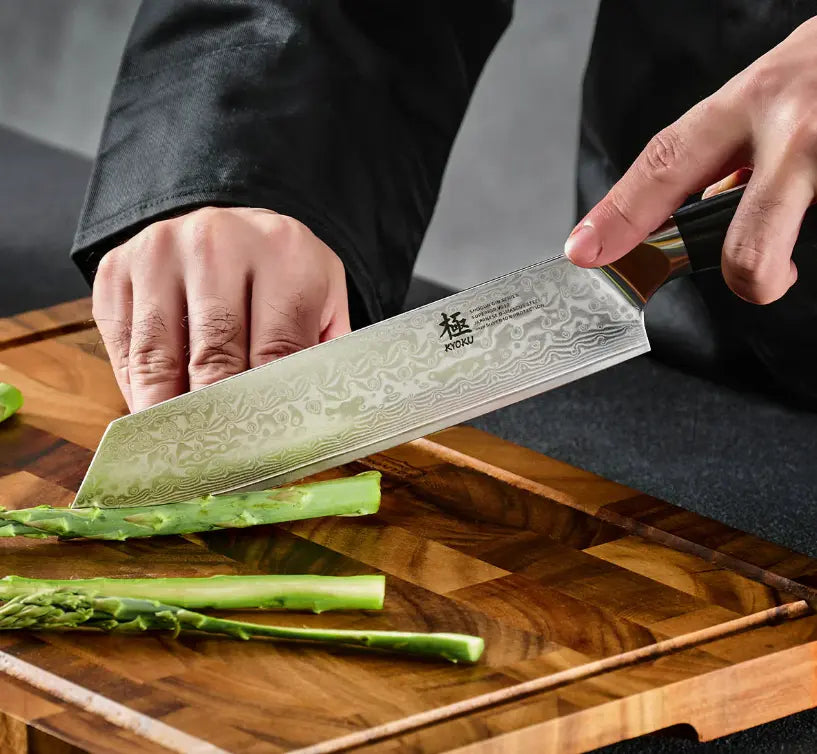As a participant in the culinary world, the choice of your knife can be as crucial as the ingredients you use. Among many kitchen tools, Japanese knives stand out for their precision, craftsmanship, and unique designs, especially the Kiritsuke and Santoku knives. Through a debate of Kiritsuke vs Santoku knives, this guide will delve deep into these two popular knife types, comparing their functionalities, designs, and culinary prowess to help you find the perfect addition to your kitchen.
What is a Kiritsuke Knife?
Originating from Japan, the Kiritsuke knife is often revered as a symbol of status and expertise in the kitchen. Generally ranging from 8 to 10 inches, the Kiritsuke blade is longer and straighter than many other knives. It is also characterized by its angled tip, which resembles a sword and is designed to perform versatile cutting tasks that require precision.
The Kiritsuke knife is a crossover between an Usuba, which is excellent for slicing vegetables, and a Yanagiba, which is ideal for slicing raw fish. This combination allows the knife to excel in tasks requiring intricate cuts and slices. It also traditionally features a single bevel edge. For those who prefer a more familiar cutting experience, some variants come with a double bevel edge, broadening the appeal and usability of Kiritsuke knives.
What is a Kiritsuke Knife Used For?
The Kiritsuke knife is best utilized for tasks that require a single slice cut, such as preparing sashimi or precisely slicing vegetables. However, due to its difficulty in handling, it is most suitable for skilled chefs who have mastered its unique blade design, particularly its single-bevel edge design. This makes it a prized tool in professional kitchens, especially for Japanese cuisine.
What is a Santoku Knife?
The Santoku knife is renowned for its multipurpose capabilities and has become a staple in both Japanese and Western kitchens. It is distinctively designed with a wide blade that ends in a sheep's foot tip, which curves sharply compared to the pointed tip of traditional Western chef's knives. Typically, the blade length ranges from 5 to 7 inches, making it shorter and easier to maneuver. Additionally, the Santoku knife often includes indentations along the edge, which can help prevent food from sticking to the knife, facilitating smoother and faster cutting.
What is a Santoku Knife Used For?
The name "Santoku", which means "three virtues" in Japanese, reflects the knife’s proficiency in three key culinary tasks: slicing, dicing, and mincing. This versatility makes the Santoku an excellent choice for handling a variety of ingredients, from meats and fish to vegetables.
Kiritsuke vs Santoku: What are the Differences?
Here is a comparison sheet that outlines the key features and best uses of the Kiritsuke knife and Santoku knife, which can provide a clear overview for you to understand their distinctions:
| Feature | Kiritsuke Knife | Santoku Knife |
| Blade Length | Typically 8 to 10 inches, longer than many other Japanese knives | Generally shorter, ranging from 5 to 7 inches |
| Blade Shape | Long and straight with an angled tip resembling a sword | Flat edge and a sheepfoot blade |
| Blade Design | Hybrid between Usuba and Yanagiba, usually with a single bevel edge; double bevel variants are available | Features a wide blade, often with Granton (indentation) edges, to prevent food from sticking |
| Best Uses | Best for tasks requiring a single slice cut such as preparing sashimi or precisely slicing vegetables. Suited for skilled chefs familiar with its features. | Excellent for slicing, dicing, and mincing various ingredients, including meats, fish, and vegetables. |
Top Kiritsuke and Santoku Knives on the Market
In professional and home kitchens, selecting the right knife can make a significant difference. Below, we highlight some of the high-quality Kiritsuke and Santoku knives that you should not miss.
1. 8.5" Kiritsuke Knives VG10 Damascus Steel | Shogun Series
This exceptional Kiritsuke knife of the Shogun Series features an 8.5-inch blade crafted from cryogenically treated Damascus steel. Its durability and sharp 8–12 degree edge can allow for effortless slicing of various ingredients, from fish to vegetables. The blade’s superior hardness rating of 58-60 on the Rockwell scale also ensures long-lasting performance and edge retention, making it a reliable choice for intricate culinary tasks.
2. 8.5" Kiritsuke Knife with Koi Scale Pattern | Koi Series
Combining artistic design with practical utility, the 8.5" Kiritsuke of the Koi Series is a testament to advanced knife crafting. The blade features a unique koi scale pattern that not only enhances the visual appeal but also helps to prevent food from sticking during slicing. Crafted from high-quality VG-10 stainless steel, this knife also offers a perfect blend of sharpness and durability, complemented by a camphor wood handle for superior grip and control.
3. 7" Japanese Santoku Knives Damascus Steel | Shogun Series
This 7" Santoku knife of the Shogun Series is a versatile tool ideal for handling a variety of cutting tasks, thanks to its 67-layered stainless Damascus steel construction. Known for its "three virtues" of slicing, dicing, and mincing, this knife features a stunning herringbone pattern at the base of the tang and a hollow edge design that ensures ingredients slide off the blade with ease, making it a practical and stylish addition to any kitchen.
4. 7" Santoku Knives 440C Steel | Daimyo Series
The 7-inch Santoku knife of the Daimyo Series uses vacuum-heated Japanese 440C stainless steel for exceptional durability and performance. Its scalpel-like 13–15 degree edge can provide precise cutting capabilities, making it ideal for various ingredients. The rosewood handle not only offers resilience against varying temperatures and conditions but also ensures comfort and balance, reducing fatigue during prolonged use.
FAQ - Kiritsuke vs Santoku Knives
Q1: What’s the main difference between Kiritsuke and Santoku knives?
A1: Kiritsuke knives are longer with a straight edge and a pointed tip, usually single-beveled, ideal for precise slicing like sashimi and delicate vegetable cuts. Santoku knives are shorter with a wider, curved blade, great for versatile tasks like slicing, dicing, and chopping a variety of ingredients.
Q2: Which knife is better for beginners?
A2: Santoku knives are more beginner-friendly because they’re versatile and easier to handle. Kiritsuke knives require more skill due to their single-edged design and longer blade, so they’re better suited for experienced cooks.
Q3: How are their blade designs different?
A3: The Kiritsuke blade is inspired by traditional Japanese knives like the Usuba and Yanagiba and is usually single-edged for precision. The Santoku blade often has scalloped edges to prevent sticking and a thicker, wider shape for all-around cutting.
Q4: What dishes are Kiritsuke knives best for?
A4: Kiritsuke knives shine with dishes that need a single, clean cut, such as sashimi and finely sliced vegetables. They’re mainly used by professional chefs.
Q5: Why is the Santoku called the “three virtues” knife?
A5: “Santoku” means “three virtues,” referring to its ability to slice, dice, and chop, making it an all-purpose favorite in the kitchen.
Q6: How should I care for Kiritsuke and Santoku knives to keep them sharp?
A6: Both knives need gentle hand washing and immediate drying to prevent rust. It’s best to sharpen Kiritsuke regularly with a whetstone due to its single edge, while Santoku knives benefit from frequent honing and occasional sharpening to maintain their edge.
Q7: Can both knives be used for cutting meat?
A7: Yes, but with some differences. Kiritsuke knives are fantastic for slicing thin, precise cuts of meat, especially raw like sashimi. Santoku knives are great for chopping and slicing cooked meat and are more versatile for general kitchen use.
In the debate of the Kiritsuke knife vs Santoku knife, choosing the right knife depends on your preference and intended use. If precision and specialized tasks are your focus, a Kiritsuke might be the right choice. However, for versatility and everyday kitchen tasks, a Santoku knife offers ease of use and efficiency. Whether you choose the Kiritsuke knife or the Santoku knife, you will elevate your kitchen capabilities.
